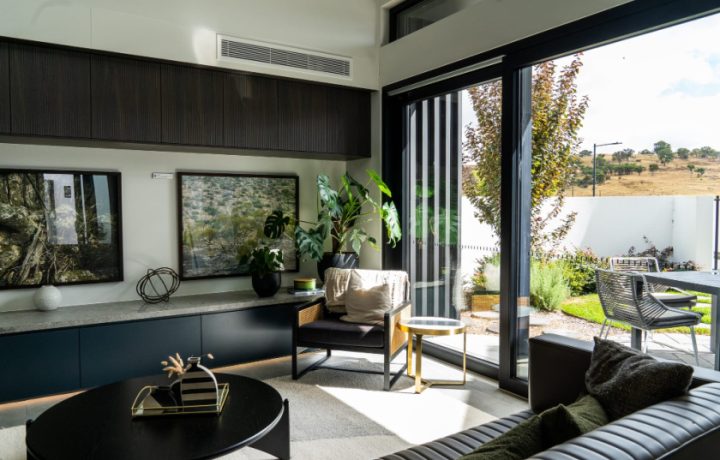Tracking Australia’s Songlines

Posted on
When Songlines: Tracking the Seven Sisters opened in mid-September at the National Museum of Australia (NMA) it quickly proved itself to be no ordinary exhibition.
Described by the Museum as a world first in its scale and complexity, Songlines features over 100 Indigenous paintings and photographs, 66 objects, song, dance and 20 multimedia components in order to narrate the story of the Seven Sisters from parts of the central and western deserts.
‘Songlines’ are a knowledge system which broadly equates with understandings of the Dreaming or more precisely Dreaming tracks: pathways of knowledge that hold complex spiritual, ecological, economic, cultural and historical knowledge. Aboriginal people travel the songlines, carrying the knowledge within them as song and dance. Crisscrossing the country, songlines are a means of naming and remembering places, of mapping the land.

Artist Painting Drawers, 2017, by Warakurna Artists
National Museum of Australia.
The Seven Sisters narrative is one of the most extensive of the songlines. The exhibition tracks the story across three deserts traversing Martu country, Anangu Pitjantjatjara Yankunytjatjara (APY) lands and Ngaanyatjarra lands encompassing three state borders.
In this ground-breaking exhibition, the narrative of the encounters between the Seven Sisters and the Ancestral being, imprinted in the land and revived each night in the sky, is not only shared with visitor but also immerses visitors to feel part of it.
Senior Indigenous curator Margo Neale, believes it is fitting the exhibition is held in Canberra, the national capital. “This is a national story,” she explains. “[Songlines are] the foundational stories of this continent. If Australians want to feel like they belong on this land, it’s critical that they know and acknowledge the foundational stories that created this land.”
In 2010 when the Anangu elders from the APY Lands in central Australia approached the Museum and the Australian National University to help restore and record this history with ancient origins, the Museum knew that this was an incredibly important task and felt compelled to do it as fulfil its obligations to tell the history of this content as known and told be ALL Australians, especially the first Australians.
The project was initiated by Indigenous elders and led by senior custodians of the Seven Sisters songline, who were compelled by the urgent need to preserve the knowledge within the ancient narratives for future generations and to promote understanding among all Australians.

National Museum of Australia. Licensed by Viscopy
Margo hopes that the exhibition makes the wider Australian public aware of the importance of Songlines and their foundational history that thread and intersect the nation.
“I hope that all Australians realise that this is their story too. It’s not just blackfellas sharing their stories [with each other]; it’s saying you’re included in this story because you live in Australia. We share this country. We share these stories.”
As a result of the exhibition, research material has been uploaded into the Aboriginal-managed digital archive Ara Irititja, in Alice Springs, in an attempt to foster intergenerational learning in Indigenous communities through the newest technologies.
A sense of theatre pervades the exhibition. Place is palpably present and country the connective tissue. Visitors can experience ‘walking’ the Seven Sisters’ songlines, Paintings act as portals to place and are sequenced to follow the sites only the journey. They can tour the exhibition with the actresses playing the Seven Sisters who take them on a rambunctious ride with an audio guide. The story is told as in a conversation between the sisters at each painting site of stunning works including sculptures and film.
One of the most breathtaking spaces in the exhibition is a six-metre-wide immersive dome theatre experience.* Lying, sitting or standing beneath the dome, visitors are transported into a significant rock art site, remote Cave Hill in South Australia, before the scene transforms into soaring three-dimensional Seven Sisters sculptures of the extraordinary grass tjanpi figures that also feature in the exhibition, set against the backdrop of the night sky.
“Songlines are our history,” says Margo. “They’re not just stories but a huge and epic narrative. They’re the stories of Australia and we are all a part of them.”
the essentials
What: Songlines: Tracking the Seven Sisters
Where: The National Museum of Australia, Lawson Crescent, Acton
When: Showing until 25 February 2018. Visit the National Museum of Australia between 9 am and 5 pm each day
Tickets: $9–17. Click here to buy tickets.
*Domelab is a research infrastructure project led by Professor Sarah Kenderdine, University of New South Wales, in partnership with the National Museum of Australia and supported by the Australian Research Council.
Feature image: Montage photographs by Sarah Kenderdine, Peter Morse and Paul Bourke. Seven Sisters rock art with permission of Walinynga (Cave Hill) custodians. Image supplied.
This is a sponsored editorial. For more information about sponsored editorials, click here.


Leave a Reply
You must be logged in to post a comment.